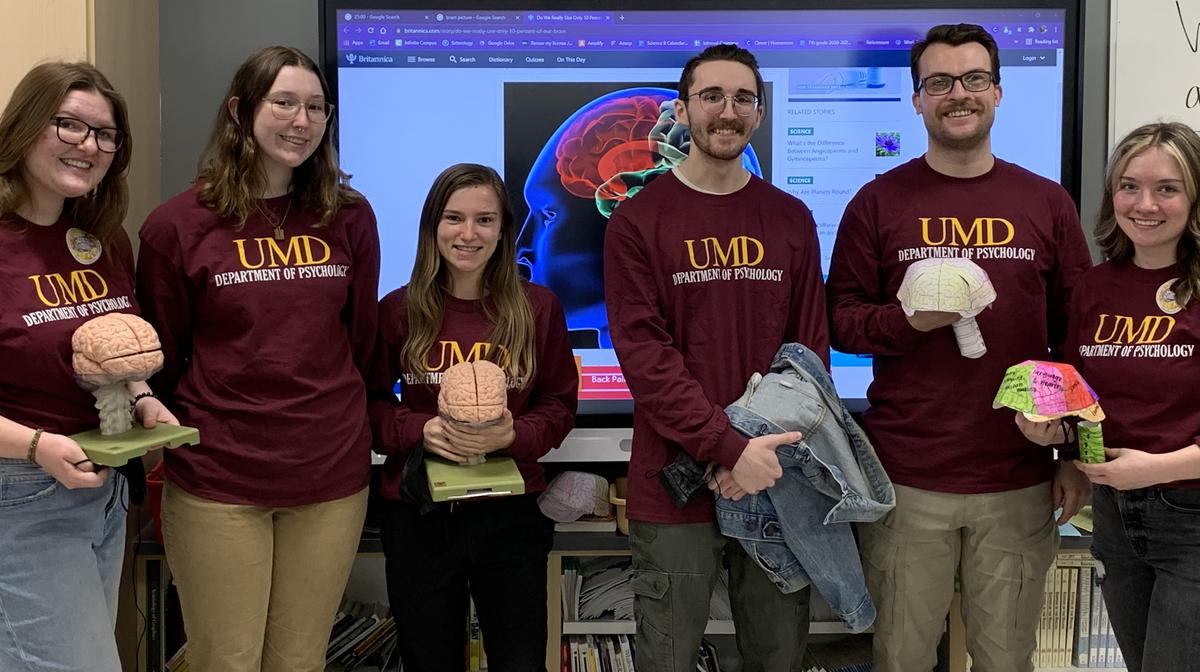Since 2015, undergraduate and graduate students in psychology have been going out to different middle schools to show students what’s really going on upstairs. A wide variety of topics is covered by the Mobile Neuroscience Lab from the anatomy of the brain to human behavior. It’s an exciting day for all who participate.
“Students really enjoy working with the middle school students,” Associate Professor Rebecca Gilbertson says. “The UMD students have an opportunity to think on their feet and practice some of the concepts that we are learning in class in a more realistic setting.”
The seventh-graders are able to witness the dissection of a sheep brain, with the psychology students pointing out different regions of the brain. The psychology students also help the middle schoolers assemble paper diagrams of a brain. Once completed, they can be worn like a hat, showing off important parts of the brain. However, it’s not always about the science—for some students, it’s the first time they’ve thought about post-high school plans.
“One of the things we always emphasize with the students is that giving back to the community is what’s really important,” Gilbertson says. “The psychology students are able to be a sort of mentor to those younger students.”
Ryan St. Clair and Sierra Swenson, two students involved in the mobile neuroscience lab, find the experience truly rewarding. “My favorite part has been learning how to teach—trying to get students as excited about the brain and their own mental capabilities as much as I myself am excited to learn about brains,” St. Clair says. “Showing them sheep brains is pretty fun too.”
This will be St. Clair’s second year as part of the neurocognitive mobile lab. A graduate student studying experimental psychology, he is hoping to become a teacher at some point in his career. Students are able to take away many different lessons from the mobile lab, he says. “I think they take away that the brain has different regions that are responsible for different functions.”
The middle school students aren’t the only ones learning–the UMD students also use the opportunity to collect data from the students. “We have them take pre and post-surveys to see how their perspective on science and learning has changed,” says St. Clair. “What influences students to be really engaged in class?”
Swenson just started in the neurocognitive lab herself but has already learned many new lessons. A sophomore double majoring in psychology and Spanish, she’s already planning her own future research. “As we’re watching the graduate students do their own research, I got really interested in doing my own research,” Swenson says. “And that’s kind of what the middle schoolers get to experience with us—we’re sharing an experience. Whether it’s neuroscience, art, chemistry, it’s really about people working together.”
Due to the pandemic, this year will be the first since 2019 for psychology students to go out in the field. Their Cloquet Middle School visits on March 17 and 18 coincide with Brain Awareness Week. “There are events happening all over the country and even internationally,” says Gilbertson. “There’s a lot of excitement about bringing neuroscience back.”
It’s a unique experience, one that students are sure not to forget. St. Clair says it best: “I hope they leave thinking that science is cooler than they initially thought.”
More about the Department of Psychology's neuroscience outreach.
Feature photo (L to R): Alli Colberg, Payton Sears, Emma Hill, Nick Kellar, Ryan St. Clair, Sierra Swenson
Not pictured: Hannah Pannell, Ashley Baumann, Kristen Jones, Mariah Ravet
This story was written by UMD student Erika Doetkott, who is majoring in Communication Sciences and Disorders. Erika assists Lissa Maki with communications for the College of Education and Human Service Professions.
